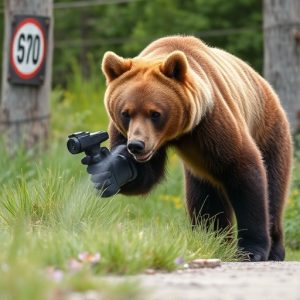Mastering Bear Spray Usage: Wilderness Safety Guide for Optimal Protection
Using bear spray effectively requires understanding its application and timing during encounters, ai…….
Using bear spray effectively requires understanding its application and timing during encounters, aiming for the bear's face and eyes at a safe distance (7-20 feet) as a last resort against aggression or charges. Don't rely solely on bear spray; combine it with awareness, noise-making, secure food storage, and other protections like pepper spray. Regular training and understanding local protocols are vital for safety in bear country.
“Enhance your wilderness safety arsenal with bear spray, a powerful tool designed to deter aggressive bears. This comprehensive guide explores ‘When to Use Bear Spray Properly’, offering insights into its functionality and effectiveness. Learn about potential threats and understand the correct deployment techniques for optimal results. Discover additional safety measures beyond bear spray to ensure a secure outdoor experience. By mastering these skills, adventurers can navigate wilderness environments with increased confidence and peace of mind.”
- Understanding Bear Spray: What It Is and How It Works
- When to Deploy Bear Spray: Identifying Potential Threats
- Correct Usage Techniques for Optimal Effectiveness
- Additional Safety Measures Beyond Bear Spray
Understanding Bear Spray: What It Is and How It Works
Bear spray, also known as bear repellent, is a powerful tool designed to deter and ward off bears in wild environments. It’s a crucial addition to any wilderness safety gear when venturing into areas inhabited by these majestic yet potentially dangerous animals. The primary function of bear spray is to create a barrier between you and the bear by emitting a potent stream of irritants that trigger an instinctive reaction in the animal, causing it to flee.
When used properly, bear spray can significantly increase your safety during encounters with bears. It’s recommended for use when approaching or encountering bears, as a last resort to prevent an attack. The spray creates a temporary but effective shield, providing you with valuable time to retreat or reevaluate your situation. Understanding the proper usage and timing of bear spray is essential for ensuring its effectiveness in potential bear encounters.
When to Deploy Bear Spray: Identifying Potential Threats
Knowing when to deploy bear spray is crucial for ensuring your safety while outdoors in bear country. It’s important to understand that bears, particularly grizzly bears, are powerful animals with strong senses, including a keen sense of smell and hearing. They can detect potential threats from miles away, so it’s essential to be mindful of your surroundings. Bear spray should be used as a last resort when facing an aggressive or defensive bear encounter, where the animal charges, makes loud noises, or displays other hostile behaviors.
Properly identifying potential threats is key. Look for signs like a bear’s scent marking, fresh tracks, or even its presence nearby. If you encounter a bear unexpectedly, make yourself appear larger by raising your arms and speaking in a calm yet assertive voice. This often discourages bears from approaching. However, if the bear continues to advance, it may be time to deploy bear spray. Aim for the bear’s face and eyes, creating a barrier that can temporarily deter or even scare the animal away.
Correct Usage Techniques for Optimal Effectiveness
When to Use Bear Spray Properly
The effectiveness of bear spray depends heavily on how and when it’s deployed. For optimal results, it’s crucial to understand the right usage techniques. Aim for the bear’s face and eyes, as these areas are sensitive and can cause immediate disorientation or even permanent damage. Keep in mind that you should use enough spray to create a dense cloud, typically about 2-3 seconds of continuous spraying from a typical canister. Always keep a safe distance, usually 7-20 feet, when deploying the spray to ensure both your safety and the bear’s.
Avoid using bear spray as a last resort or if you’re in close proximity to a bear already. It should be employed only when you encounter a defensive or aggressive bear. Additionally, remember that weather conditions can affect the spray’s range and effectiveness; wind, rain, or fog might reduce its impact. Staying calm, following safety protocols, and using bear spray judiciously can significantly enhance your wilderness safety experience.
Additional Safety Measures Beyond Bear Spray
When navigating wild spaces where bears are known to roam, it’s crucial to go beyond bear spray as your sole safety measure. While bear spray is an effective deterrent in many situations, understanding when and how to use it properly is key. It should be a last resort when a bear shows signs of aggression or approaches closely. Additionally, keeping food securely stored and making noise while hiking can help deter bears before they become confrontational.
Other essential safety practices include staying alert and aware of your surroundings, traveling in groups, and knowing how to properly respond if you encounter a bear. Carrying other forms of protection like pepper spray, a whistle, or bear bells can also enhance your safety. Regular training and staying informed about local bear behavior and protocols are vital steps for anyone venturing into bear country.
Bear spray is an invaluable tool for wilderness safety, but its effectiveness hinges on proper usage. Understanding when and how to deploy it is key. By recognizing potential threats, employing correct technique, and complementing bear spray with other safety measures, adventurers can minimize risks during encounters in wild environments. Remember, knowledge and preparation are essential for a safe and enjoyable outdoor experience.


